University of Kansas
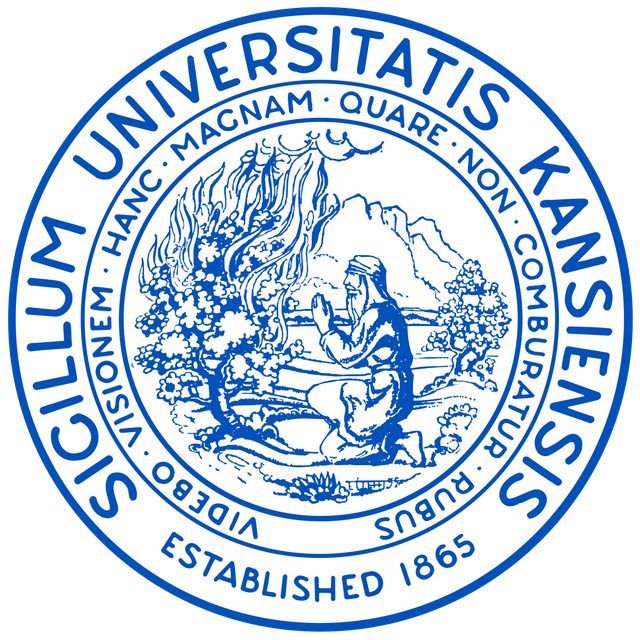
University of Kansas

| Latin: Universitas Kansiensis | |
| Motto | Videbo visionem hanc magnam quare non comburatur rubus (Latin) |
|---|---|
Motto in English | "I will see this great vision in which the bush does not burn." (Exodus 3:3)[1] |
| Type | Public Flagship[2] |
| Established | March 21, 1865 (1865-03-21)[3] |
| Affiliation | Kansas Board of Regents |
Academic affiliation | AAU, APLU, Educause |
| Endowment | $1.741 billion (2018)[4] |
| Chancellor | Doug Girod |
| Provost | Carl W. Lejuez (interim) |
Academic staff | 2,663[5] |
| Students | 27,690 (Fall 2019)[6] |
| Location | Lawrence, Kansas, United States 38°57′29″N 95°14′52″W [81] |
| Campus | College town, Urban, 1,100 acres (450 ha) |
| Colors | Crimson and Blue[7] |
| Nickname | Jayhawks |
Sporting affiliations | NCAA Division I – Big 12 |
| Mascots | Big Jay and Baby Jay |
| Website | www.ku.edu [82] |
 | |
| University rankings | |
| National | |
| ARWU[26] | 67–94 |
| Forbes[27] | 260 |
| Times/WSJ[28] | 238 |
| U.S. News & World Report[29] | 130 |
| Washington Monthly[30] | 183 |
| Global | |
| ARWU[31] | 201–300 |
| QS[32] | 372 |
| Times[33] | 351-400 |
| U.S. News & World Report[34] | 266 |
The University of Kansas, also referred to as KU, is a public research university with its main campus in Lawrence, Kansas, and several satellite campuses, research and educational centers, medical centers, and classes across the state of Kansas.[8] Two branch campuses are in the Kansas City metropolitan area on the Kansas side: the university's medical school and hospital in Kansas City, the Edwards Campus in Overland Park, and a hospital and research center in the state's capital of Topeka. There are also educational and research sites in Garden City, Hays, Leavenworth, Parsons, and Topeka, and branches of the medical school in Salina and Wichita. The university is one of the 62 members of the Association of American Universities.
Founded March 21, 1865, the university was opened in 1866, under a charter granted by the Kansas State Legislature in 1864[9] and legislation passed in 1863 under the State Constitution, which was adopted two years after the 1861 admission of the former Kansas Territory as the 34th state into the Union. Disputes over Kansas' establishment as a free or slaveholding state prior to admission to the union prompted an internal civil war known as "Bleeding Kansas" during the 1850s.[10]
Kansas's athletic teams compete in NCAA Division I sports as the Jayhawks, as members of the Big 12 Conference. They field 16 varsity sports, as well as club-level sports for ice hockey, rugby, and men's volleyball.
| Latin: Universitas Kansiensis | |
| Motto | Videbo visionem hanc magnam quare non comburatur rubus (Latin) |
|---|---|
Motto in English | "I will see this great vision in which the bush does not burn." (Exodus 3:3)[1] |
| Type | Public Flagship[2] |
| Established | March 21, 1865 (1865-03-21)[3] |
| Affiliation | Kansas Board of Regents |
Academic affiliation | AAU, APLU, Educause |
| Endowment | $1.741 billion (2018)[4] |
| Chancellor | Doug Girod |
| Provost | Carl W. Lejuez (interim) |
Academic staff | 2,663[5] |
| Students | 27,690 (Fall 2019)[6] |
| Location | Lawrence, Kansas, United States 38°57′29″N 95°14′52″W [81] |
| Campus | College town, Urban, 1,100 acres (450 ha) |
| Colors | Crimson and Blue[7] |
| Nickname | Jayhawks |
Sporting affiliations | NCAA Division I – Big 12 |
| Mascots | Big Jay and Baby Jay |
| Website | www.ku.edu [82] |
 | |
| University rankings | |
| National | |
| ARWU[26] | 67–94 |
| Forbes[27] | 260 |
| Times/WSJ[28] | 238 |
| U.S. News & World Report[29] | 130 |
| Washington Monthly[30] | 183 |
| Global | |
| ARWU[31] | 201–300 |
| QS[32] | 372 |
| Times[33] | 351-400 |
| U.S. News & World Report[34] | 266 |
History
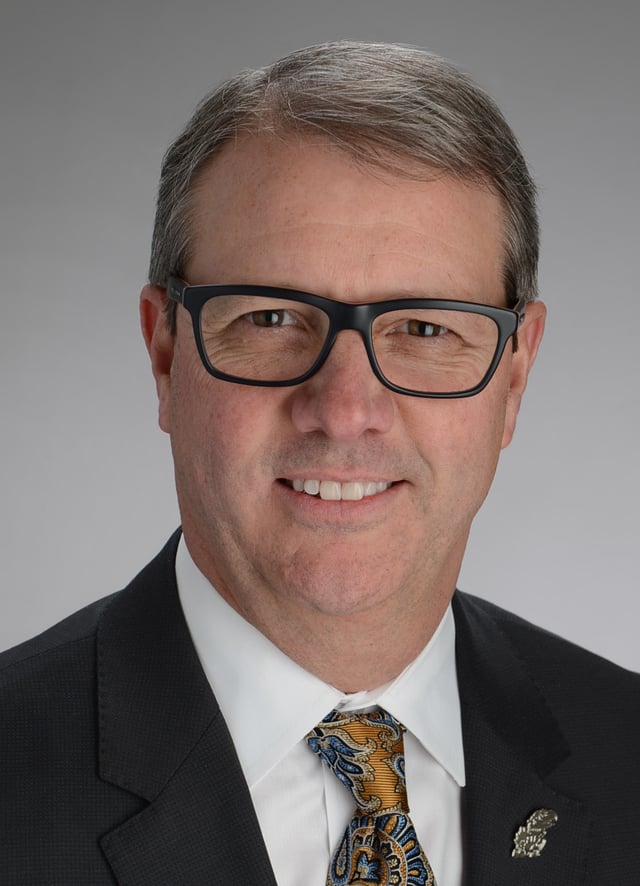
Doug Girod, KU's current chancellor
On February 20, 1863, Kansas Governor Thomas Carney signed into law a bill creating the state university in Lawrence.[15] The law was conditioned upon a gift from Lawrence of a $15,000 endowment fund and a site for the university, in or near the town, of not less than forty acres (16 ha) of land.[16] If Lawrence failed to meet these conditions, Emporia instead of Lawrence would get the university.
The site selected for the university was a hill known as Mount Oread, which was privately donated by Charles L. Robinson, Republican governor of the state of Kansas from 1861 to 1863, and one of the original settlers of Lawrence, Kansas. Robinson and his wife Sara bestowed the 40-acre (16 ha) site to the State of Kansas in exchange for land elsewhere.[16] The philanthropist Amos Adams Lawrence donated $10,000 of the necessary endowment fund, and the citizens of Lawrence raised the remaining money themselves via private donations.[16] On November 2, 1863, Governor Carney announced Lawrence had met the conditions to get the state university, and the following year the university was officially organized.[9] The school's Board of Regents held its first meeting in March 1865, which is the event that KU dates its founding from.[3][17] Work on the first college building began later that year.[9] The university opened for classes on September 12, 1866, and the first class graduated in 1873.[9] According to William L. Burdick, the first degree awarded by the university was a Doctor of Divinity, bestowed upon noted abolitionist preacher Richard Cordley.[18]
During World War II, Kansas was one of 131 colleges and universities nationally that took part in the V-12 Navy College Training Program which offered students a path to a Navy commission.[19]
Famous landmarks and structures
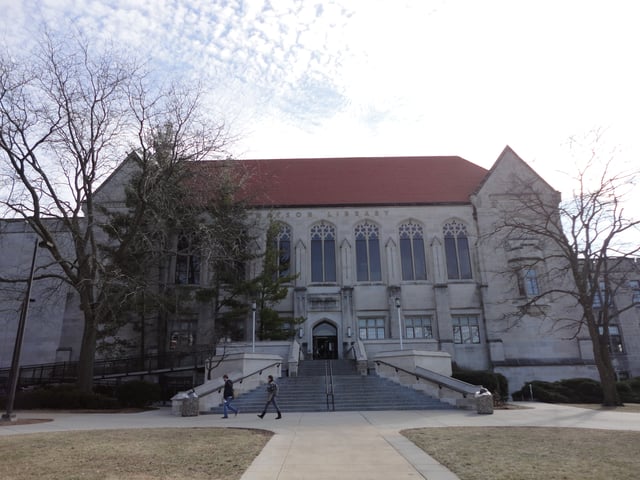
The main branch of the Watson Library (2015).
KU is home to the Robert J. Dole Institute of Politics, the Beach Center on Disability, Lied Center of Kansas and radio stations KJHK, 90.7 FM, and KANU, 91.5 FM. The university is host to several museums including the University of Kansas Natural History Museum and the Spencer Museum of Art. The libraries of the University include Watson Library,[20] Kenneth Spencer Research Library,[21] the Murphy Art and Architecture Library,[22] Thomas Gorton Music & Dance Library,[23] and Anschutz Library.[24] Of athletic note, the university is home to Allen Fieldhouse, which is heralded as one of the greatest basketball arenas in the world, and David Booth Kansas Memorial Stadium, which is the eighth oldest college football stadium in the country.[25]
Academics
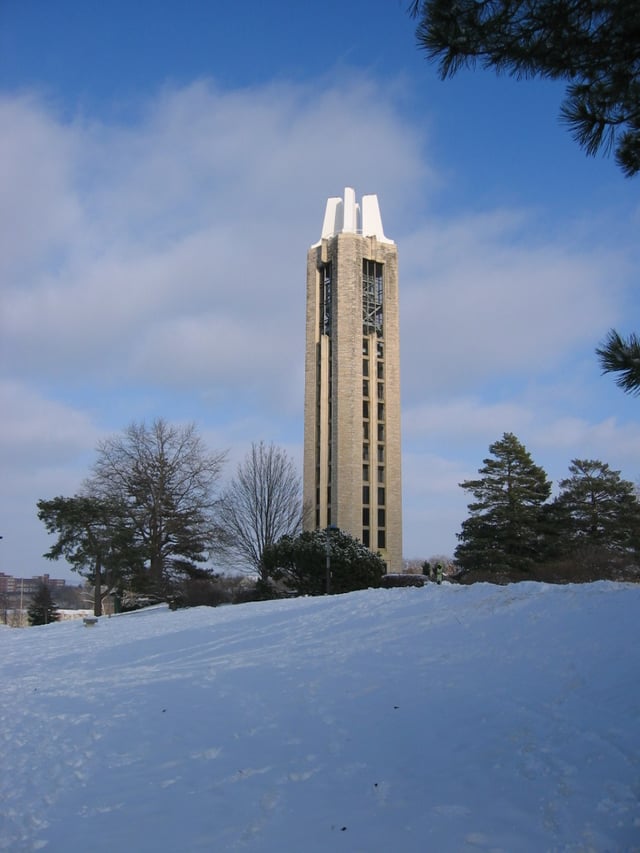
World War II Memorial Campanile
The University of Kansas is a large, state-sponsored university with five campuses. KU is a member of the Association of American Universities (AAU)[35] and it is classified among "R-1: Doctoral Universities – Highest Research Activity" by the Carnegie Classification of Institutions of Higher Education.[36] KU features the College of Liberal Arts & Sciences, which includes the School of the Arts and the School of Public Affairs & Administration; and the schools of Architecture, Design & Planning; Business; Education; Engineering; Health Professions; Journalism & Mass Communications; Law; Medicine; Music; Nursing; Pharmacy; and Social Welfare. The university offers more than 345 degree programs.
In its 2020 report, U.S. News & World Report ranked KU as tied for 130th place among National Universities and 59th place among public universities.[37]
School of Architecture and Design
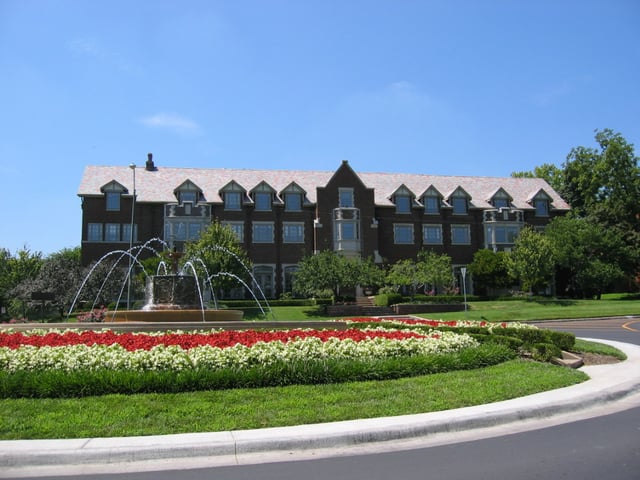
Chi Omega Fountain
The University of Kansas School of Architecture and Design (Arc/D), with its main building being Marvin Hall, traces its architectural roots to the creation of the architectural engineering degree program in KU's School of Engineering in 1912. The Bachelor of Architecture degree was added in 1920. In 1969 the School of Architecture and Urban Design (SAUD) was formed with three programs: architecture, architectural engineering, and urban planning. In 2001 architectural engineering merged with civil and environmental engineering. The design programs from the discontinued School of Fine Arts were merged into the school in 2009 forming the School of Architecture, Design, and Planning (SADP) with three departments. In 2017, the Urban Planning department merged into KU's School of Public Affairs and Administration. Accordingly, the SADP was renamed to the School of Architecture and Design (Arc/D).
According to the journal DesignIntelligence, which annually publishes "America's Best Architecture and Design Schools," the School of Architecture and Design at the University of Kansas was named the best in the Midwest and ranked 11th among all undergraduate architecture programs in the U.S in 2012.[38]
School of Business
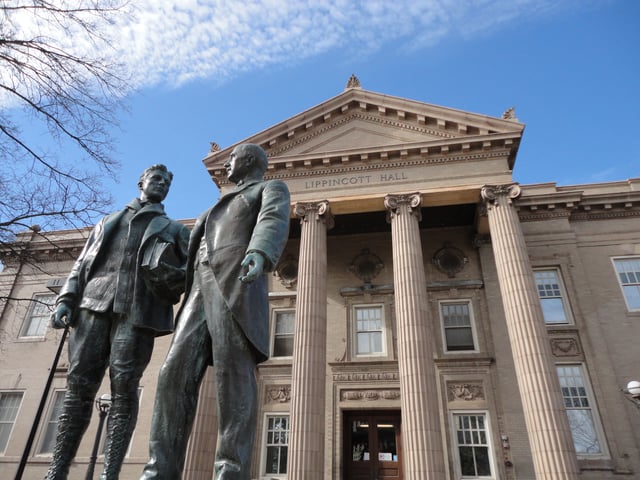
Lippincott Hall - Offices of Study Abroad and The Wilcox Museum
The University of Kansas School of Business is a public business school on the main campus of the University of Kansas in Lawrence, Kansas. The KU School of Business was founded in 1924 and has more than 80 faculty members and approximately 1500 students.[39]
Named one of the best business schools in the Midwest by Princeton Review, the KU School of Business has been continually accredited by the Association to Advance Collegiate Schools of Business (AACSB) for its undergraduate and graduate programs in business and accounting.[40]
In 2016, The University of Kansas completed construction on a new home for the business school, named Capitol Federal Hall. It is located at 1654 Naismith Drive, near KU's Rec Center and across the street from Allen Fieldhouse. Capitol Federal Hall is a 166,500 square-foot building complete with state-of-the-art technology and several research labs.[41]
School of Law
The University of Kansas School of Law, founded in 1878, was the top law school in the state of Kansas, and tied for 65th nationally, according to the 2016 U.S. News & World Report "U.S. News Best Colleges Rankings."[37] Classes are held in Green Hall at W 15th St and Burdick Dr, which is named after former dean James Green.[42]
School of Engineering
The KU School of Engineering is an ABET accredited, public engineering school located on the main campus. The School of Engineering was officially founded in 1891, although engineering degrees were awarded as early as 1873.[43]
In the *U.S. News & World Report'*s "America’s Best Colleges" 2016 issue, KU's School of Engineering was ranked tied for 90th among national universities.[37]
Notable alumni include: Alan Mulally (BS/MS), former President and CEO of Ford Motor Company, Lou Montulli, co-founder of Netscape and author of the Lynx web browser, Brian McClendon (BSEE 1986), VP of Engineering at Google, Charles E. Spahr (1934), former CEO of Standard Oil of Ohio.
School of Journalism and Mass Communications

The William Allen White School of Journalism

The Natural History Museum
The William Allen White School of Journalism and Mass Communications is recognized for its ability to prepare students to work in a variety of media. The school offers two tracts of study: 1) News and Information, and 2) Strategic Communication. This professional school teaches students reporting for print, online and broadcast, strategic campaigning for PR and advertising, photojournalism and video reporting and editing. The J-School's students maintain various publications on campus, including The University Daily Kansan, Jayplay magazine, and KUJH TV. In 2008, the Fiske Guide to Colleges praised the KU J-School for its strength. In 2010, the School of Journalism and Mass Communications placed second at the prestigious Hearst Foundation national writing competition.[44]
Medical Center
The University of Kansas Medical Center features three schools: the School of Medicine, School of Nursing, and School of Health Professions that each has its own programs of graduate study. As of the Fall 2013 semester, there were 3,349 students enrolled at KU Med.[13] The Medical Center also offers four year instruction at the Wichita campus, and features a medical school campus in Salina, Kansas devoted to rural health care.
The university-affiliated independent University of Kansas Hospital is co-located at the University of Kansas Medical Center.
The Edwards Campus, Overland Park
KU's Edwards Campus is in Overland Park, Kansas. Established in 1993, its goal is to provide adults with the opportunity to complete undergraduate, graduate and certificate programs. About 2,000 students attend the Edwards Campus, with an average age of 31.[45] Programs available at the Edwards Campus include business administration, education, engineering, social work and more.
The University of Kansas Leavenworth
Near the beginning of the 2018-2019 school year, the University of Kansas launched classes in Leavenworth, Kansas, offering classes to "both civilian and military" students, emphasizing a "high priority in supporting military-affiliated students." The Leavenworth classes offer both undergraduate and graduate courses.[46]
Tuition
Beginning in the 2007–2008 academic year, first-time freshman at KU pay a fixed tuition rate for 48 months according to the Four-Year Tuition Compact passed by the Kansas Board of Regents. For the 2014–15 academic year, tuition was $318 per credit hour for in-state freshman and $828 for out-of-state freshmen. For transfer students, who do not take part in the compact, 2014–15 per-credit-hour tuition was $295 for in-state undergraduates and $785 for out-of-state undergraduates; subject to annual increases. Students enrolled in 6 or more credit hours also paid an annual required campus fee of $888.[47] The schools of architecture, music, arts, business, education, engineering, journalism, law, pharmacy, and social welfare charge additional fees.
As of August 2019, the annual tuition for 30 credit hours for a freshman is estimated by the university to be $10,182, not counting room and board costs.[48]
Computing innovations
KU's School of Business launched interdisciplinary management science graduate studies in operations research during Fall Semester 1965. The program provided the foundation for decision science applications supporting NASA Project Apollo Command Capsule Recovery Operations.
KU's academic computing department was an active participant in setting up the Internet and is the developer of the early Lynx text based web browser. Lynx provided hypertext browsing and navigation prior to Tim Berners Lee's invention of HTTP and HTML.[49]
Student activities
Athletics

Kansas Jayhawks wordmark as of 2018
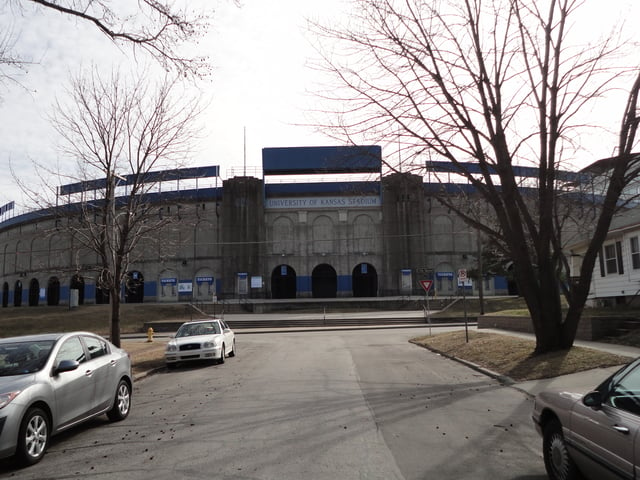
Memorial Stadium
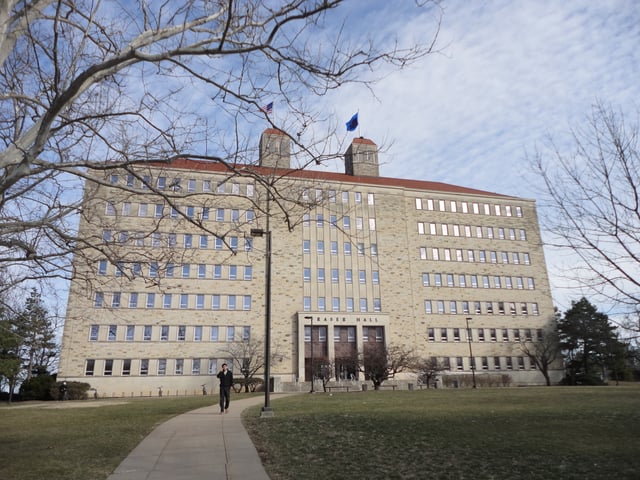
Fraser Hall - KU's Landmark Academic Building
The school's sports teams, wearing crimson and royal blue, are called the Kansas Jayhawks. They participate in the NCAA's Division I and in the Big 12 Conference. KU has won thirteen National Championships: five in men's basketball (two Helms Foundation championships and three NCAA championships), three in men's indoor track and field, three in men's outdoor track and field, one in men's cross country and one in women's outdoor track and field. The home course for KU Cross Country is Rim Rock Farm. Their most recent championship came on June 8, 2013 when the KU women's track and field team won the NCAA outdoor in Eugene, Oregon becoming the first University of Kansas women's team to win a national title.[50]
KU football dates from 1890, and has played in the Orange Bowl three times: 1948, 1969, and 2008. They are currently coached by Les Miles, who was hired in 2018.[51] In 2008, under the leadership of Mark Mangino, the #7 Jayhawks emerged victorious in their first BCS bowl game, the FedEx Orange Bowl, with a 24–21 victory over the #3 Virginia Tech Hokies. This capstone victory marked the end of the most successful season in school history, in which the Jayhawks went 12–1 (.923). The team plays at David Booth Kansas Memorial Stadium, which recently underwent a $31 million renovation to add the Anderson Family Football Complex, adding a football practice facility adjacent to the stadium complete with indoor partial practice field, weight room, and new locker room.
The KU men's basketball team has fielded a team every year since 1898. The Jayhawks are a perennial national contender, coached by Bill Self. The team has won five national titles, including three NCAA tournament championships in 1952, 1988, and 2008. The basketball program is currently the second winningest program in college basketball history with an overall record of 2,248-848 through the 2017–18 season. The team plays at Allen Fieldhouse. Perhaps its best recognized player was Wilt Chamberlain, who played in the 1950s, later becoming an NBA star and Harlem Globetrotter. Other notable Jayhawk basketball players include Phog Allen (who would later become head coach of the Jayhawks), Dean Smith, Jo Jo White, Danny Manning, Jacque Vaughn, Paul Pierce, Raef LaFrentz, Nick Collison, Kirk Heinrich, Mario Chalmers, Marcus Morris, Markieff Morris, Andrew Wiggins, and Joel Embiid, among others.
Kansas has counted among its coaches Dr. James Naismith (the inventor of basketball), Basketball Hall of Fame inductee Phog Allen ("the Father of basketball coaching" and a Kansas alumnus himself), Basketball Hall of Fame inductee Roy Williams, and Basketball Hall of Fame inductee and former NBA Champion Detroit Pistons coach Larry Brown. Currently, Kansas is coached by Basketball Hall of Fame inductee Bill Self. In addition, legendary University of Kentucky coach and Basketball Hall of Fame inductee Adolph Rupp played for KU's 1922 and 1923 Helms National Championship teams, and NCAA Hall of Fame inductee and University of North Carolina Coach Dean Smith played for KU's 1952 NCAA Championship team. Both Rupp and Smith played under Phog Allen. Allen also coached Hall of Fame coaches Dutch Lonborg and Ralph Miller. Allen founded the National Association of Basketball Coaches (NABC), which started what is now the NCAA Tournament. The Tournament began in 1939 under the NABC and the next year was handed off to the newly formed NCAA.[52]
Notable non-varsity sports include rugby, men's hockey, and men's soccer. The rugby team owns its private facility and internationally tours every two years.
Sheahon Zenger was introduced as KU's new athletic director in January 2011.[53] Under former athletic director Lew Perkins, the department's budget increased from $27.2 million in 2003 (10th in the conference) to currently over $50 million thanks in large part to money raised from a new priority seating policy at Allen Fieldhouse, a new $26.67 million eight-year contract with Adidas replacing an existing contract with Nike, and a new $40.2 million seven-year contract with ESPN Regional Television. The additional funds brought improvements to the university, including:[54]
The Booth Family Hall of Athletics addition to Allen Fieldhouse
Brand new offices and lounges for the women's basketball program
Brand new scoreboard and batting facility for the baseball field
A new $35 million football facility adjacent to Memorial Stadium
The $8 million 42,000-square-foot (3,900 m2) Anderson Family Strength Center
Debate teams
The University of Kansas has had more teams (70) compete in the National Debate Tournament than any other university.[55] Kansas has won the tournament 6 times (1954, 1970, 1976, 1983, 2009 and 2018)[56] and had 15 teams make it to the final four.[55] Kansas trails only Northwestern (15) and Harvard (7) for most tournaments won, and is tied with Dartmouth (6). Kansas also won the Copeland Award in 1981-82 and 2017-18.
Anthems
Notable among a number of songs commonly played and sung at various events such as commencement and convocation, and athletic games are: "I’m a Jayhawk", "Fighting Jayhawk", "Kansas Song", "Sunflower Song", "Crimson and the Blue", "Red and Blue", the "Rock Chalk, Jayhawk" chant", "Home on the Range" and "Stand Up and Cheer."[57]
Media
The university's newspaper is University Daily Kansan, which placed first in the Intercollegiate Writing Competition of the prestigious William Randolph Hearst Writing Foundation competition, often called "The Pulitzers of College Journalism" in 2007. In Winter 2008, a group of students created KUpedia, a wiki about all things KU. They received student funding for operations in 2008–09. The KU Department of English publishes the Coal City Review, an annual literary journal of prose, poetry, reviews and illustrations. The Review typically features the work of many writers, but periodically spotlights one author, as in the case of 2006 Nelson Poetry Book Award-winner Voyeur Poems by Matthew Porubsky.[58][59]
The university houses the following public broadcasting stations: KJHK, a student-run campus radio station, KUJH-LP, an independent station that primarily broadcasts public affairs programs, and KANU, the NPR-affiliated radio station. Kansas Public Radio station KANU was one of the nation's first public radio stations. KJHK, the campus radio has roots back to 1952 and is completely run by students.
Housing

Potter Lake, with Joseph R. Pearson Hall in the background
| KU Student Housing[62] | Year opened | Year closed | Students | Accommodations |
|---|---|---|---|---|
| Battenfeld Hall | 1940 | 50 | Men only | |
| Corbin Hall | 1923 | 900 | Women only | |
| Douthart Hall | 1954 | 50 | Women only | |
| Ellsworth Hall | 1963 | 580 | All Students | |
| Gertrude Sellards Pearson Hall(GSP) | 1955 | 380 | All Students | |
| Grace Pearson Hall(GP) | 1955 | 50 | Men only | |
| Guest House | 2 | Visiting Guests | ||
| Hashinger Hall | 1962 | 370 | All Students | |
| Jayhawker Towers | 200 | Non-traditional, Upperclassmen, Transfer students | ||
| K.K. Amini Hall | 1992 | 50 | All Students[63] | |
| Krehbiel Hall | 2008 | 50 | Men only | |
| Lewis Hall | 1962 | 260 | All Students | |
| Margret Amini Hall | 2000 | 50 | Women only | |
| Marie S. McCarthy Hall | 2015 | 38 | Men Only: Upperclassmen/Non-Traditional Students[64] | |
| McCollum Hall | 1965 | 2015 | 976 | Razed November 25, 2015 [65] |
| Miller Hall | 1937 | 50 | Women only | |
| Oliver Hall | 1966 | 660 | All Students | |
| Oswald Hall | 2015 | 350 | Freshmen only | |
| Pearson Hall | 1952 | 47 | Men only | |
| Rieger Hall | 2005 | 50 | Women only | |
| Self Hall | 2015 | 350 | Freshmen only | |
| Sellards Hall | 1952 | 47 | Women only | |
| Stephenson Hall | 1952 | 50 | Men only | |
| Stouffer Place | 1957 | 2015 | Graduate Students, Couples, Non-Traditional | |
| Templin Hall | 1959 | 280 | All Students | |
| Transition Housing | 19 | KU Faculty and Staff (temporary) | ||
| Watkins Hall | 1925 | 50 | Women only | |
| Total | 4,534 students |
Foundations
University of Kansas Memorial Corporation
The first union was built on campus in 1926 as a campus community center.[66] The unions are still the "living rooms" of campus and include three locations – the Kansas Union and Burge Union at the Lawrence Campus and Jayhawk Central at the Edwards Campus. The KU Memorial Unions Corporation manages the KU Bookstore (with seven locations). The KU Bookstore is the official bookstore of KU. The Corporation also includes KU Dining Services, with more than 20 campus locations, including The Market (inside the Kansas Union) and The Underground (located in Wescoe Hall). The KU Bookstore and KU Dining Services are not-for-profit,[67] with proceeds supporting student programs, such as Student Union Activities.[68]
KU Endowment
KU Endowment was established in 1891 as the university's primary institutional foundation. Its mission is to partner with donors in providing philanthropic support to build a greater University of Kansas.[69]
Notable alumni and faculty
325 Fulbright Scholars,[70] 27 Rhodes Scholars,[71] 12 MacArthur Fellows,[72] 7 Pulitzer Prize winners,[73] 4 NASA astronauts,[73] 3 Nobel Prize laureates, 2 Fields Medal winners, 2 Hugo Award and Nebula Award winners (James E. Gunn, Kij Johnson, John Kessel), and an Academy Award winner have been affiliated with the university as students, researchers, or faculty members.
See also
Bailey Hall (University of Kansas)
Budig Hall
Kansas Audio-Reader Network
Kansas Crew (University Rowing Club)
Kansas Song
Home on the Range
University of Kansas Marching Jayhawks